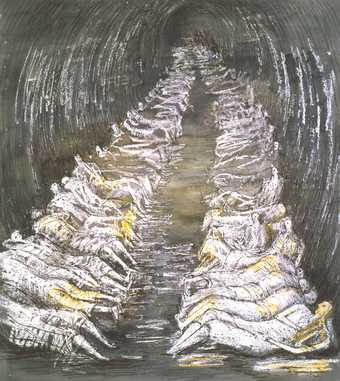
Henry Moore OM, CH
Tube Shelter Perspective
(1941)
Tate
Basic, or linear perspective rests on the fact that although parallel lines never meet, they appear to do so as they get further away from the viewer towards the horizon, where they disappear. The sides of a road, or later, railway lines, are obvious examples. In painting all parallel lines, such as the roof line and base line of a building, are drawn so as to meet at the horizon if they were extended. This creates the illusion of distance, and the point at which the lines meet is called the vanishing point. Things look smaller the further away they are, and perspective enabled painters accurately and consistently to calculate the size things should be in relation to their supposed distance from the viewpoint.
Linear perspective was invented in Italy in the early fifteenth century and first developed by the painter Paolo Uccello. Early perspective systems used a single fixed viewpoint with a single vanishing point. Later, multiple vanishing points were introduced which enabled a much more naturalistic representation of a scene to be made, because it was closer to the way we actually see, that is, from two eyes which are in constant motion.
Atmospheric, or aerial perspective, creates the sense of distance in a painting by utilising the fact that the atmosphere appears more blue in the distance.
